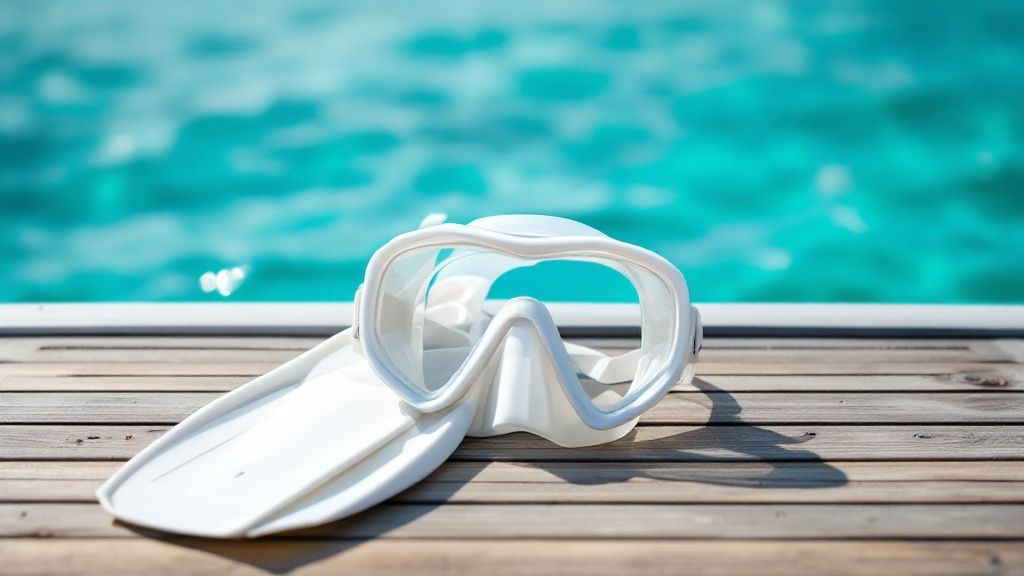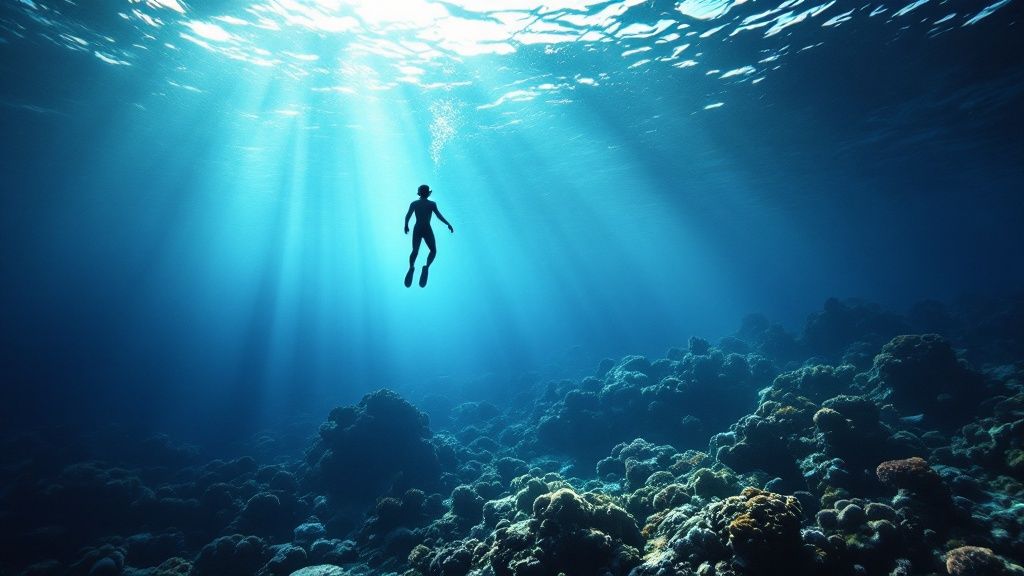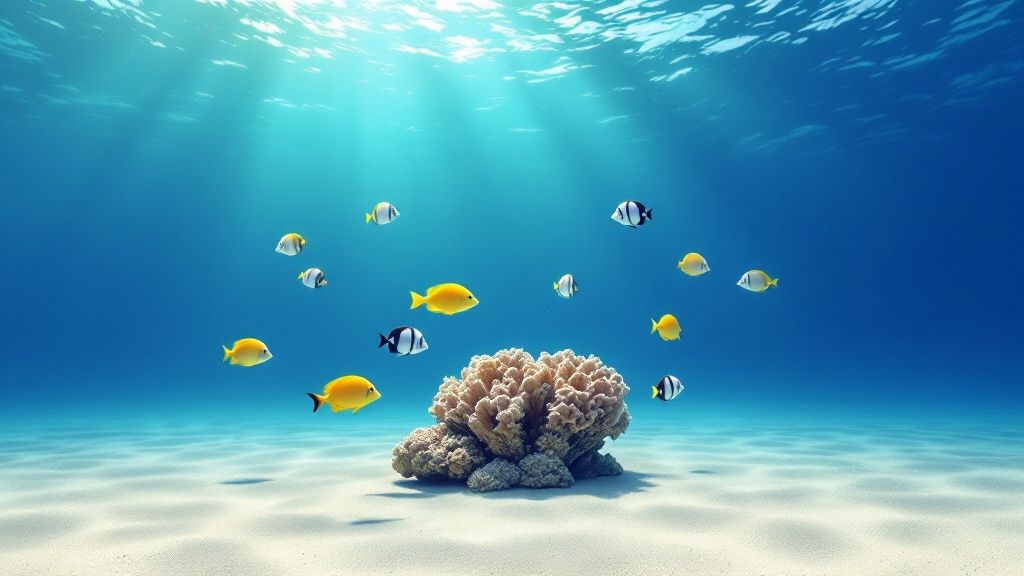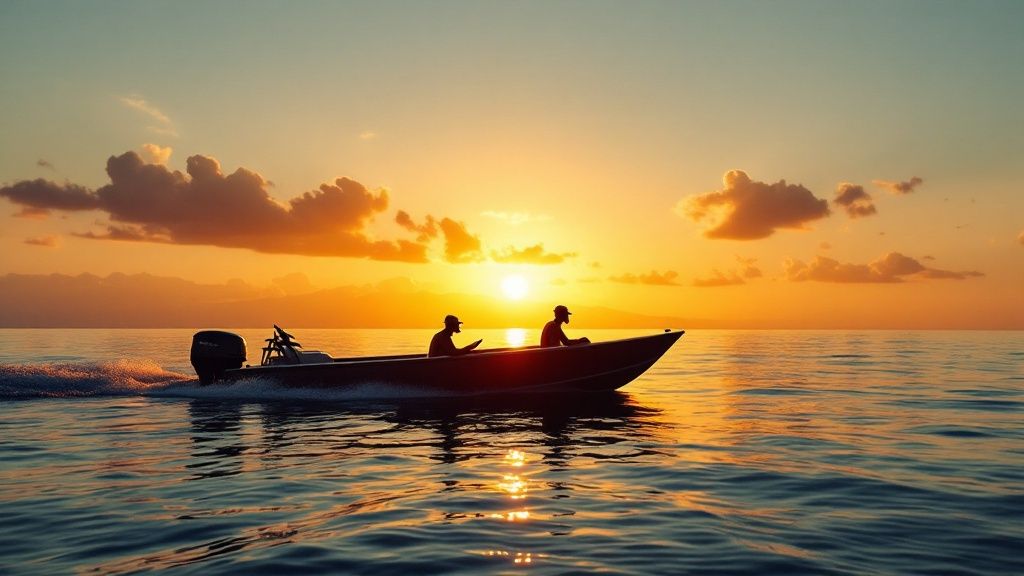Your Guide to the Captain Cook Snorkel Tour

A Captain Cook snorkel tour is one of those quintessential Big Island experiences, and for good reason. It’s far more than just a boat trip; it’s a journey into the crystal-clear waters of Kealakekua Bay, a place that’s part history lesson, part underwater spectacle.
This isn't just any snorkeling spot. The bay is a protected marine sanctuary, home to some of the most vibrant coral reefs in Hawaii. It’s also the very place where Captain James Cook first landed on the island, tying your adventure directly to a major moment in Hawaiian history. You’re literally swimming through a living aquarium with a deep cultural story.
What Makes This Snorkel Tour So Unforgettable

Picture this: you're floating effortlessly in calm, turquoise water as schools of brilliant yellow tangs swirl around you. In the distance, a stark white monument stands against a backdrop of dramatic, ancient cliffs. That’s the magic of a Captain Cook snorkel tour. It’s an experience that perfectly weaves together three amazing elements into one fantastic day on the water.
A Fusion of History and Nature
What really elevates this adventure is the way it blends stunning natural beauty with a powerful sense of the past. Kealakekua Bay isn’t just a premier snorkeling destination; it’s a place that holds deep cultural significance for Hawaiians. This dual appeal is a huge reason why it draws over 190,000 visitors each year.
While everyone comes for the incredible marine life, many are just as fascinated by the story of Captain Cook’s arrival and his eventual death right on this shoreline. In fact, for roughly 70% of participants, the rich historical context is a major part of the draw. It turns a fun activity into something much more meaningful. If you're curious, you can learn more about the history of Kealakekua Bay and how to experience it yourself.
This tour is more than just an activity; it's a story. You're not just swimming with fish—you're floating through a pivotal location in Hawaiian and world history, adding a layer of depth you won't find anywhere else.
The Core Experience
At its heart, the tour is all about delivering a world-class snorkeling experience in a protected marine sanctuary. The bay’s naturally calm conditions and incredible water clarity make it the perfect place to see a staggering variety of sea creatures.
For a quick overview, here's what you can generally expect from a tour.
Captain Cook Snorkel Tour At a Glance
| Feature | Description |
|---|---|
| Location | Kealakekua Bay State Historical Park, a protected marine sanctuary. |
| Primary Activity | Snorkeling in front of the Captain Cook Monument. |
| Marine Life | High chances of seeing spinner dolphins, sea turtles (Honu), and hundreds of species of tropical fish. |
| Water Conditions | Typically calm, clear, and protected from open ocean swells. |
| Historical Element | The tour centers around the site of Captain Cook's landing and death. |
| Accessibility | The best snorkeling area is primarily accessible by boat tour or a difficult hike. |
This combination of history, easy snorkeling conditions, and abundant wildlife is exactly why it’s considered one of the most memorable adventures you can have on the Big Island. The bay is truly special.
Discover the Rich History of Kealakekua Bay

Snorkeling in Kealakekua Bay feels like swimming through a living history book. Long before European ships ever graced these shores, this spot was a deeply sacred and vital place for Native Hawaiians. Its very name, Kealakekua, means "the pathway of the gods," which tells you everything you need to know about its spiritual importance.
This sheltered inlet was once the bustling center of a large Hawaiian community. The dramatic cliffs that frame the bay, known as Pali Kapu O Keōua, aren't just a pretty backdrop; they’re filled with ancient burial caves holding the iwi (bones) of high chiefs. When you're floating in the water here, you're in the presence of generations of Hawaiian history.
The Arrival of Captain Cook
The bay's story took a sharp turn in January 1779 when British explorer Captain James Cook sailed in. His two ships, the HMS Resolution and HMS Discovery, were the first European vessels to ever anchor in these calm waters.
As fate would have it, Cook arrived during the Makahiki festival, a peaceful season honoring the god Lono. The timing, along with the sheer spectacle of the massive ships, led some Hawaiians to believe Cook might be Lono himself. He was greeted with incredible honor and ceremony, kicking off a period of fascinating cultural exchange. But it didn't last.
A Tragic Clash of Cultures
Before a month had passed, the friendly relations had completely frayed. A series of misunderstandings and disputes boiled over, leading to a violent confrontation on the shoreline of Kaʻawaloa Cove on February 14, 1779. In the chaos, Captain Cook and four of his marines were killed.
You can’t miss the stark white obelisk that stands there today. The Captain Cook Monument marks the approximate spot of this pivotal encounter, a silent reminder of a complicated and world-changing moment.
Every Captain Cook snorkel tour gives you a front-row seat to this landmark. The best guides don't just point it out; they weave the bay's full story—from its Hawaiian roots to its role in marine conservation—into your experience. This is what makes a guided tour so much more than just a boat ride.
Understanding the bay's past transforms your snorkel trip. It goes from a fun day on the water to a truly meaningful connection with Hawaiian history. You're not just looking at fish; you're exploring a place with immense cultural gravity.
This rich historical backdrop adds a powerful dimension to the adventure. To get an even better feel for the whole experience, take a look at our complete guide on what to expect from a Kealakekua Bay snorkeling tour.
Explore an Underwater Paradise

The moment your mask slips beneath the surface, everything changes. While the history is fascinating, the true magic of a Captain Cook snorkel tour is the vibrant, living world waiting just below. Kealakekua Bay is a protected Marine Life Conservation District, and you’ll instantly understand why. It feels like you’ve just been dropped into the world’s most beautiful aquarium.
The water clarity here can be absolutely astounding. On a good day, sunlight cuts straight through the blue, lighting up sprawling coral gardens in vivid detail. The bay’s geography is key—it’s a deep inlet shielded by steep cliffs, which protects it from the powerful open ocean swells. This creates an incredibly calm, nutrient-rich sanctuary where marine life flourishes.
The Inhabitants of the Bay
What makes this place so special is the sheer density and diversity of life. You’re not just looking for a fish or two; you're literally swimming through entire schools of them. It’s this incredible abundance that consistently ranks this spot among Hawaii’s best for snorkeling.
You can expect to see:
- Massive Schools of Fish: Picture being surrounded by a shimmering cloud of yellow tangs, their brilliant color flashing as they move. Keep an eye out for parrotfish munching on coral, quirky triggerfish, and countless other species.
- Hawaiian Green Sea Turtles (Honu): Seeing one of these ancient, graceful reptiles glide by is a moment you won't forget. They are a common sight, often cruising along the reef or resting peacefully on the seafloor.
- Playful Spinner Dolphins: While there are no guarantees in the wild, pods of spinner dolphins often come into the bay in the mornings to rest and socialize. If you’re lucky, you might even catch them living up to their name with some spectacular acrobatic leaps.
The experience is completely immersive. The reef drops off steeply near the monument, so you can float in relatively shallow water and gaze down into the deep blue. It’s like looking into a multi-story apartment building, with different creatures living at every level.
A Living Coral Garden
The coral reef is the foundation for this entire underwater city. The reef here is remarkably healthy, with some coral heads estimated to be hundreds of years old. These living, intricate structures provide food, shelter, and nurseries for a mind-boggling number of species.
Snorkeling here is a chance to see these delicate formations up close. The coral creates a complex tapestry of nooks and crannies where smaller creatures hide and thrive. Trying to spot all the different species becomes part of the fun. To get a head start, check out our detailed Hawaiian fish identification guide—it’ll help you put a name to the colorful faces you meet.
The bay’s protected status is what keeps it so pristine. By being a responsible snorkeler, every person on a Captain Cook snorkel tour plays a part in preserving this underwater paradise for generations to come. The explosion of color and constant motion of the reef is a powerful and humbling reminder of nature’s delicate beauty.
How to Choose Your Perfect Snorkel Tour

Picking the right Captain Cook snorkel tour is a bigger deal than most people think. It’s not just about getting to the bay; the boat you choose, the size of your group, and the general vibe of the trip will completely shape your day on the water. It’s like deciding between a lively resort pool party and a quiet, hidden cove—both are fantastic, but you have to know what you’re in the mood for.
Hawaii's tour operators offer something for just about everyone, and the prices reflect that diversity. You'll see tours ranging anywhere from $90 to over $220 per person. That price difference often comes down to group size, how long you're out on the water, and what's included. Some of the smaller boats might take just 6-12 people on a four-hour trip, while the big catamarans could host 40 guests with a full lunch spread. You can get a good feel for the different Captain Cook snorkeling tour options out there to see what clicks with your style.
So, let's get into the nitty-gritty of what you'll be choosing between.
Large Vessels Versus Small Boats
Your biggest decision will likely be between a big, steady catamaran and a smaller, zippier raft, often called a Zodiac. Each offers a totally different kind of day, and one is definitely not better than the other—it just depends on what you want out of your adventure.
Large catamarans are essentially floating oases. If you’ve got young kids, are a bit nervous about being on the open ocean, or just prioritize comfort, this is your ticket. These boats are loaded with amenities that just make the day easier and more enjoyable.
- Onboard Restrooms: A non-negotiable for many, especially on longer trips.
- Ample Shade: The Hawaiian sun is no joke, and a shady spot to relax is a huge bonus.
- Food and Drinks: Most include snacks, a decent lunch, and beverages to keep you going.
- Fun Extras: Some of the bigger boats even have water slides, which are always a hit!
On the other hand, you have the small, zodiac-style rafts. Think of these as the sports cars of the sea. They offer a much more intimate, up-close-and-personal adventure. They're faster, ride low to the water, and can often duck into sea caves and explore lava tubes that the bigger boats simply can't get to.
This is the perfect tour for experienced snorkelers or anyone with a real sense of adventure. If you want to spend as much time as possible in the water and see the rugged coastline up close, a small boat is the way to go. The smaller group size also means you get a more personalized experience with your captain and crew.
To make things a little clearer, here’s a quick breakdown of what you can expect from each type of tour.
Comparison of Captain Cook Snorkel Tour Types
| Feature | Large Vessel Tours (Catamarans) | Small Boat Tours (Zodiacs) |
|---|---|---|
| Best For | Families, first-timers, comfort-seekers | Adventurous travelers, small groups |
| Group Size | Typically larger (20-50+ people) | Smaller, more intimate (6-16 people) |
| Stability | Very stable, smooth ride | Bouncier, more exhilarating ride |
| Amenities | Restrooms, shade, food, slides | Minimal (often no restroom or shade) |
| Vibe | Relaxed, social, "resort-like" | Adventurous, fast-paced, "explorer" |
Ultimately, the best tour is the one that fits your travel style. Once you know what kind of day you’re looking for—whether it's total relaxation or a thrilling expedition—you can book your Captain Cook snorkel tour with confidence, knowing you’ve picked the perfect boat for an unforgettable Big Island adventure.
Getting Ready for Your Day on the Water
A little planning goes a long way in turning a great snorkel tour into an absolutely perfect one. When you've got everything sorted out beforehand, you can spend less time worrying about what you forgot and more time soaking in the incredible views.
The good news is that your tour operator handles the heavy lifting. They'll provide all the high-quality snorkel gear—we're talking masks, snorkels, and fins. They'll also have flotation devices like noodles and life vests on hand, so everyone can feel comfortable and confident in the water.
What to Toss in Your Bag
While the main gear is taken care of, packing a few key items will make your day so much more comfortable. Think of it as your personal go-kit for a day at sea.
Here’s a quick checklist of what you should bring:
- Reef-Safe Sunscreen: This is a huge one. It's essential for protecting your skin and, just as importantly, Hawaii's fragile coral reefs.
- Sun-Blocking Clothes: A long-sleeved rash guard is your best friend out here, offering way better protection than sunscreen alone when you're floating face-down. Don't forget a wide-brimmed hat and a good pair of polarized sunglasses for the boat ride.
- A Towel & Dry Clothes: Nothing beats having a fluffy towel for the ride back to shore. A dry shirt to change into is also a game-changer.
- Underwater Camera: Trust me, you're going to want to capture what you see down there. A waterproof camera or even a secure phone case is a must.
The biggest mistake people make is underestimating the power of the Hawaiian sun. A rash guard gives you bulletproof protection that doesn't need to be reapplied and won't harm the marine life.
Being prepared also means knowing how to be safe out there. Your guides are experts and will give you a full briefing, but it never hurts to brush up on the basics yourself. We've put together a handy guide on essential snorkeling safety tips that's worth a read before you go.
Once you know what to pack—and what to leave at home—you're all set for a totally stress-free adventure. With your bag ready, you can just sit back and get ready to dive into the magic of Kealakekua Bay.
Snorkeling with Aloha and Respect
Visiting Kealakekua Bay is a real privilege, and we all have a part to play in keeping this place special. It all comes back to a powerful Hawaiian concept: mālama i ka ʻāina, which translates to "caring for and protecting the land." Think of it as a guiding principle for our visit—a call to be thoughtful guests in this sacred spot.
This spirit of respect starts on the shore and extends to every fish, turtle, and piece of coral beneath the waves. The number one rule in the water is simple: look, but please don't touch. Imagine the reef as a living art gallery. You can get up close to admire everything, but touching the exhibits can cause damage that lasts a lifetime.
Why Your Actions Matter
The coral reefs here are unbelievably fragile. A single accidental kick with a fin can destroy decades of slow coral growth, and even the natural oils on our skin can be harmful to sensitive animals like sea turtles.
To help you leave this underwater sanctuary just as beautiful as you found it, please keep these simple guidelines in mind:
- Keep Your Distance: Always maintain a respectful distance from sea turtles (Honu), dolphins, and other marine life. Chasing or getting too close stresses them out and disrupts their natural behavior.
- Never Stand on Coral: It might look like a rock, but coral is a living colony of tiny animals. Standing on it crushes and kills the very organisms that built the reef over centuries.
- Use Reef-Safe Sunscreen: This one is a big deal. Common sunscreen chemicals like oxybenzone and octinoxate are extremely toxic to coral, leading to bleaching and death. Always double-check your sunscreen's label for "reef-safe" ingredients.
A mindful visitor understands that small actions create a huge collective impact. Simply choosing the right sunscreen and keeping your fins off the reef are powerful acts of aloha that help protect this paradise for years to come.
Every Captain Cook snorkel tour is more than just a fun day on the water; it's a chance to practice this kind of mindful tourism, ensuring this natural treasure thrives for the next generation.
Common Questions About the Captain Cook Tour
Alright, let's wrap things up by tackling some of the questions I hear all the time from people planning their trip. Getting these details ironed out beforehand means you can just show up and enjoy the day.
What Is the Best Time of Year for This Tour?
Honestly, Kealakekua Bay is incredible any time of year because it’s so well-protected. But if you’re looking for those postcard-perfect, glassy-calm conditions, the summer months are your best bet. Think April through October, when the ocean is usually super calm and the visibility feels like it goes on forever.
That's not to say winter is a bad time—far from it. From November to March, you might get bigger ocean swells, but you also get a massive bonus: it’s humpback whale season! The boat ride to and from the bay can turn into an amazing whale-watching trip. No matter the season, though, morning tours almost always have the calmest water.
Do I Need to Be a Strong Swimmer?
Not at all. You definitely don't need to be Michael Phelps to have a blast out there. Every good tour company provides flotation gear, like pool noodles or snorkel vests, so you can just float effortlessly on the surface and take in the view.
The crew always runs through a safety briefing and shows you how to use the equipment before you even hop in. As long as you're reasonably comfortable being in the water, you'll be perfectly fine. Just speak up and let the guides know if you're feeling a little nervous—that's what they're there for.
The whole point is to make this experience accessible. The crew is there to make sure you feel safe, so you can focus on the incredible fish below you instead of worrying about staying afloat.
Can I Reach the Monument Without a Boat?
Technically, yes, but I really don't recommend it for most visitors. The alternative is a very tough 4-mile round-trip hike down (and then back up) a steep, rocky, and often slippery trail. It’s a serious workout.
For that reason alone, taking a licensed captain cook snorkel tour is by far the easiest, safest, and most enjoyable way to get there. The boat drops you right in the heart of the action, provides all your gear, and has a professional crew watching over you.
Are There Restrooms on the Boats?
This is a great, practical question! The answer really depends on the boat. The bigger catamarans and larger vessels almost always have a marine restroom (or a "head," as it's called on a boat).
The smaller, more adventurous zodiac-style rafts, however, usually don't have onboard facilities simply because they don't have the space. If having a restroom is a must for you, make sure to ask the tour company when you're booking. It’s always a good practice to use the restrooms at the harbor before you head out, just in case.
Ready to explore the vibrant underwater world of Kealakekua Bay? Kona Snorkel Trips offers unforgettable tours led by lifeguard-certified guides who are passionate about sharing the magic of Hawaii's marine life. Book your adventure today!
